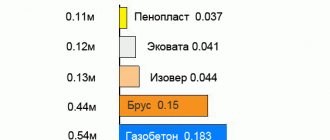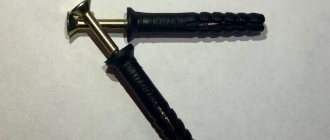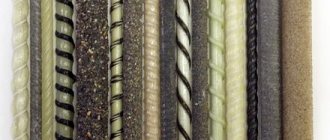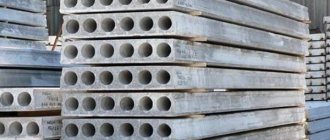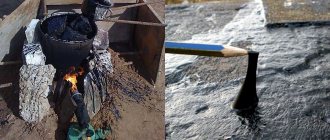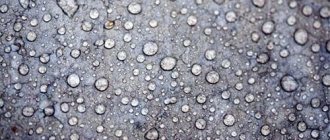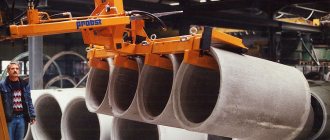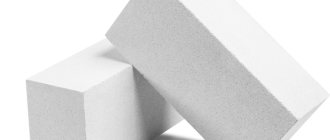- Application of screenings in concrete preparation
- Advantages and disadvantages compared to sand
- Concrete from screenings and sand: selecting proportions
- Features of mortar made from granite screenings
- Making concrete: mixing technology
- Advice from professionals
Screened concrete is widely used in construction due to its low cost of components and acceptable quality. Let's look at the proportions and technology for preparing such a solution.
The use of concrete mortar prepared using crushed stone screenings is a common practice in construction. Such a solution has a low cost, and the quality of the monolith obtained after hardening of the concrete mass is sufficient to solve most problems. Let's figure out what the proportions of components for concrete mortar from screenings are, and also consider the technology for preparing this composition.
Application of screenings in concrete preparation
During the preparation of crushed stone, particles of various diameters are formed. After passing them through sieves, various fractions of crushed stone and screenings are formed - the smallest particles that cannot be included in any of the fractions. Although screenings cannot be used together with crushed stone, they are quite capable of replacing sand in the preparation of many brands of concrete mortar.
The use of dropouts appears economically attractive. However, from time to time on construction forums one comes across complaints about the poor quality of the resulting concrete monolith. Therefore, before starting construction work, many builders wonder whether it is worth saving, or whether it is better to use sand and not worry about the quality of the finished concrete.
Experts say that in some cases, using screenings instead of sand is not only possible, but even preferable. Such solutions are made not only in individual construction, but also in centralized production in concrete plants.
Complaints about poor quality are usually due to one of three reasons:
- Deliberately high expectations.
- Error when choosing brand of screening. Here the reason may be incorrectly selected material, particle size or low quality filler (large proportion of clay and dust particles in the composition).
- Violation of solution preparation technology.
We provide a table of the suitability of various brands of screenings for the preparation of different types of concrete solutions. With its help, you will easily understand in which cases you can take screenings, and in which it is better to leave the sand:
This table is of a advisory nature. Data may vary slightly depending on region. For example, screenings of diorite, for which low suitability for concrete production is indicated, has quite appropriate strength characteristics. It was given this rating due to its high price in many areas of our country.
How is screening done?
At enterprises that specialize in the production of crushed stone from granite, the process of creating screenings looks like this.
- The raw rock is transported to special equipment that carries out the procedure for crushing rock stones;
- As soon as the crushed crushed stone is reduced in size, it is sent to a screening device. Already at this stage, it is possible to obtain screenings of crushed granite stone, the total volume of which is 15% of the volume of crushed stone produced. Material with more than 5 millimeters does not belong to sand, but is full-fledged crushed stone. Therefore, if the resulting product has grains up to 5 millimeters in size, it can safely be called screening;
- Then each batch of products prepared for sale certainly goes to the laboratory. Specialists take a small sample to check the composition of the finished batch. If the physical and molecular composition is normal, and the grains correspond to the established standard size, the batch is allowed for sale;
- The finished granite screenings are sent to a warehouse, where they are stored until the moment of purchase.
Advantages and disadvantages compared to sand
Screening has a number of advantages compared to sand. These features make it an excellent choice as a filler for preparing concrete mass:
- Screenings are a by-product of making crushed stone or dismantling old concrete structures. This makes it a significantly cheaper material compared to sand. The use of cheaper filler allows you to reduce the cost of each cubic meter of solution, which provides significant cost savings for large-scale work.
- The screening is durable, fills all the voids in the formwork well, and is practically not afraid of temperature changes. This has a positive effect on the durability of the concrete monolith and increases the service life of the finished product.
- There are no clay or organic impurities in the screenings prepared using the technology. The content of dust particles depends on the variety, but is usually also lower than in sand. In addition, it is easier to wash the screenings to remove dust.
The formation of the screening price is greatly influenced by the cost of transportation. Depending on the distance from the quarry to the construction site, as well as the thoughtfulness of logistics solutions, the cost of even high-quality varieties of this filler can be very low.
At the same time, the screening of some rocks (for example, granite, diabase, etc.) has a number of specific features. First of all, granite, depending on the deposit, may have quite noticeable background radioactivity. In order for a material to meet safety requirements and be suitable for use in residential construction, its radioactivity should not exceed 370 Bq/kg.
The second feature is differences in hydrophilicity associated with the acidity of the rock. Thus, rocks with an acidic environment (for example, granite) are well saturated with water and give the concrete mass a dense, homogeneous structure. In rocks with an alkaline reaction environment (limestone, diabase) a hydrophobic effect is observed. Therefore, plasticizers will have to be added to the concrete solution.
Material characteristics
Crushed stone screening has certain characteristics that determine its scope of application:
- resistance to mechanical loads;
- size;
- embankment density;
- high frost resistance;
- various shapes of grains - needle-shaped and flat;
- amount of various impurities.
If you search on the Internet “how much does screening cost,” you will notice that this material is budget-friendly and allows you to reduce overall costs during construction or other work.
Concrete from screenings and sand: selecting proportions
The ratio of components used to prepare the concrete mass significantly affects its strength, durability and performance characteristics. The classic recipe involves the use of cement powder, sand and crushed stone. Screenings (depending on the grain size) are used both to replace sand and to replace crushed stone.
To calculate the optimal ratios for a solution in which screenings partially replace coarse and partially fine filler, use the table below:
The table is compiled based on the use of M400 cement. The weight of cement powder is taken as a unit, and the weight of the main components is obtained by multiplying the given mass fractions by the weight of cement. For example, to prepare 1 cubic meter. M200 concrete, you will need:
- Cement M400 – 286 kg.
- Crushed stone - 286 kg x 3.9 = 1115.4 kg.
- Sand - 286 kg x 1.7 = 486.2 kg.
- Dropout – 286 kg x 2 = 572 kg.
All component weights are based on dry conditions. The weight of water is obtained by multiplying the total mass of dry matter by 0.2. For our example, you will need 2459.6 kg x 0.2 = 491.92 kg (or l.) of water.
For ease of use, the obtained values are rounded to whole values and converted into buckets.
Mortar without sand: we use only screenings
For the production of fine-grained varieties of concrete mass, it is possible to completely replace both sand and crushed stone with screenings. The solution, therefore, consists of only two dry components: cement powder and screenings. The proportions for this case are shown in the table:
The calculation principle is similar to the previous one: we take the mass of cement, multiply it by the fraction of screenings in the selected type of cement mass, and get the mass of dry components. So, for the M300 variety you will need (per 1 cubic meter) 382 kg of M400 cement and 382 kg x 4.5 = 1719 kg of screenings. As in the previous case, the mass of water is 20% (0.2) of the mass of dry components.
Where is granite crushed stone screening used?
Granite sand from crushed stone is mainly used in the process of road construction. It is not divided into fractions, since the size of each grain is 1-5 millimeters. The sharp corners of the rock fragments are ideal for use in the construction industry. Due to its high strength index (1200 kgf/cm2), crushed granite screenings can be used in reinforced concrete structures of average load-bearing capacity. In concrete mixtures, this building material is used as a complete replacement for sand. That is why builders, with limited financial resources, turn their attention specifically to screening out crushed stone from granite rock. In terms of radioactivity, the finished product belongs to the first class, being completely harmless to humans.
As a result, the potential buyer gets a good opportunity to save money.
Features of mortar made from granite screenings
Granite screening is obtained by crushing granite layers. In this case, the screening particles have high hardness and are practically not afraid of mechanical deformation or temperature changes.
Granite chips have uneven edges, which has a positive effect on the ability to bond with cement into a durable monolith. The particle diameter is usually 2-5 mm. A characteristic feature of granite screenings is their beautiful natural color (pink, greenish, gray). Concrete mass prepared with the addition of granite screenings is well suited for the manufacture of paving slabs and other decorative structures.
The dismantling of concrete structures that have outlived their allotted time is also accompanied by the formation of screenings. Both pure concrete screening and material with the addition of brick chips obtained during the dismantling of old masonry are distinguished. With the low cost of such screening, its properties are less stable: they largely depend on the quality of the original concrete monolith, as well as the degree of development of the processes of its natural destruction.
The characteristics of a particular batch of concrete chips may differ from the values stated by the manufacturer. Therefore, it is permissible to use a solution based on concrete screenings for the manufacture of products that do not bear significant loads: paths in parks, floors in technical rooms, garden structures, etc.
Using Sand Screening
Sand screenings are pieces of rock that remain after washing the main sand mass. This material is not used in cement concrete mixtures.
Screenings are a waste material in the production of crushed stone, so their cost is several times less. Therefore, many people want to use just such a mixture.
Finishing putty: types, application technique and characteristics. Tips for choosing the best compositionKnauf plaster - characteristics, properties, types, applications and mixing of the mixture (105 photos)
Do-it-yourself floor screed: types, construction technology and advice on choosing materials and tools. Video instructions and 110 photos from professionals
But the use of such material is only possible for structures with low loads. And then, only a small part of the main crushed stone can be replaced.
Making concrete: mixing technology
Mixing large batches is carried out using concrete mixers, since it is difficult to mix the solution by hand. In addition, with such mixing it is almost impossible to guarantee the homogeneity of the mass. Here is the algorithm:
- Cement and screenings are measured according to previously made calculations. Each component is sieved to ensure that the material is free of stones, debris and other unwanted contaminants.
- Dry materials in specified proportions are loaded into a concrete mixer and mixed thoroughly.
- Water is added in small portions and mixed thoroughly. Excess water will cause cracks to appear on the monolith, so there is no need to rush to add it.
Screed. Sand or screenings?
ratnik.74, since you brought sand to the apartment, then, of course, the mortar for the screed will be prepared right on the spot. What will it be mixed with? The quality of mixing the solution greatly affects the final quality of the concrete. This is where the difference can be made, whether it’s just sand plus cement, or sand, plus screenings, plus cement. Mixing sand and cement is much easier. Even a powerful low-speed drill can be used to mix in small portions, not to mention a special hand-held mortar mixer. But to mix with the screenings, for this you need a small classic concrete mixer. Do builders have such equipment? If not, kick them in the face - they're hacks. Or buy a ready-made solution at the factory, with delivery by automixer. In order for the concrete to turn out to be of high quality, when preparing the solution, the proportion B(oda):C(ment) must be observed. With the correct proportion of water, there is so little water that without equipment (concrete mixer, mortar mixer) the solution is almost impossible to mix. Therefore, builders, either forced or intentional, to make their lives easier, add water, worsening the quality of concrete. I highly recommend checking it out for yourself. Mix 5-6 liters of cement-sand mortar by hand in a bucket. Try, say, 0.7 - 0.8 for the B:C ratio (although even less is actually needed). If you mix it by hand, the mixture will look more like wet sand. And then mix (for longer) the mixture with an electric drill with a special insert (there are small ones called “paint mixers”). The mixture will now turn into a solution, albeit quite hard. And then add a little liquid detergent to the solution as a plasticizer (a teaspoon of Fairy would be great) and stir well with a drill. You will receive a fairly plastic solution that will not delaminate for a long time, without adding excess water. So you will understand why high-quality mixing and concrete plasticizers are needed. Further, in order to obtain a screed of the highest possible quality, you will have to prepare a hard solution, i.e., not flowable due to the small amount of water, despite thorough mixing in a concrete mixer. Compacting such a solution, and even with screenings, will only be possible with the help of a vibrating screed.
The conclusion suggests itself - you need to look for professional builders who have all the necessary equipment and not be a fool yourself so that they don’t screw up, plus vigilantly monitor all stages of the process.
Advice from professionals
To give you a better idea of the technology for preparing mortar from cement powder and screenings, we have prepared several useful videos. These videos also contain useful tips from experienced builders on preparing concrete mortar from waste material:
With the correct selection of proportions and the use of high-quality components, a concrete solution mixed using screenings will not be inferior to a traditional cement-sand-crushed stone mixture. At the same time, significant cost savings are achieved, which makes the use of screening in construction a justified solution. Good luck with your work!
Screening and its application in construction
Screenings are a material that is not very common in civil and industrial construction. Its use is quite limited. But its characteristics allow it to find a wider range of applications. Especially in individual construction. This article is devoted to the application of screening.
What is dropout?
The word “screening” means nothing more than crushed stone of very small fractions, which does not fit the standard dimensions determined by GOST. Because, the size of the dropout ranges from 0 to 5 and from 3 to 10 mm. Most often, the composition of the screenings includes both of these fractions and, thus, the granulometric composition of the screenings becomes closer to sand than to crushed stone.
Screenings are most often granite. Since small fragments of sufficient strength not to crumble into sand are obtained when crushing hard rocks. But you can also find screenings of gabrodiabase, basalt, marble, and limestone. However, it is granite screening that is in greatest demand.
This material comes in two colors - gray and red. However, this division is quite arbitrary, since granite does not have a pure gray color, as well as red, in nature. Rather, we should talk about shades of gray and pink. Marble screenings have a white or grayish color, basalt and gabrodiabase screenings are black, limestone screenings have a grayish tint.
What is the difference between sand and screenings?
Sand and screenings are bulk materials used in construction. To an ignorant person, at first glance they may seem the same, but there is a difference between them. What is the difference between sand and screenings and what is the scope of application of both? Let's look at it below.
What is sand and what is screening?
Sand is a sedimentary rock composed of quartz grains (most commonly). The grain size is no more than 5 millimeters. Sand is mined in quarries or on river banks, and natural or artificial washing with water allows dust particles and foreign inclusions (for example, clay) to be removed from it. Experts distinguish several types of sand - according to the degree of purification, the size of the grains, and the rock material.
Sand is used for the production of concrete and products made from it:
- blocks;
- well rings;
- tubing;
- reinforced concrete trusses, etc.
In addition, sand is used in the production of paving slabs, in the construction of embankments, in the construction of roads, bridges, hydraulic structures, for sandblasting and much more. Dyed sand has found application in landscape design.
Screenings, like sand, have grain sizes of no more than 5 millimeters (in most cases), however, they are not sedimentary rocks, but a product of crushing factories in stone quarries. In professional language, screening is called “crushed stone of fraction 0-5”. This is the main difference between dropouts and sand. Here, perhaps, it is worth making a retreat and explaining something. At the quarry, after crushing the stone, it is sorted; for this purpose, units called “screens” are used. They are vibrating inclined grates along which large pieces of stone are rolled onto a conveyor, and small pieces fall into cells and are poured into heaps. Everything that falls into cells measuring 5 by 5 millimeters is screening.
The fundamental difference between sand and screenings is the presence of a large number of very small particles in the latter. Therefore, there is always a cloud of dust in the sorting areas during work. Screenings are in demand in the production of asphalt concrete, mortars and landscape design. It can be used in the production of paving slabs and some grades of concrete, but most often in these cases sand is still used. The most valuable screening is granite (due to the strength of the material). Other types - for example, screenings from porphyrite - are of less importance.
Comparison
It is clear that if the production of screening requires a whole complex of various operations, machines and units (blasting operations, crushers, screens), then its cost is much higher than the cost of sand, which is most often simply scooped out of a quarry with an excavator. Indeed, sand is sold at prices several times lower than the cost of crushed stone. It is interesting that when selling crushed stone, a concept such as “bulk weight” is used. This means that a cubic meter of screenings (fraction 0-5, where the grains are located close to each other and fill the volume as much as possible) will weigh more than a cubic meter of fraction 60-100, where there will be a lot of free space between the grains (actually cobblestones). The bulk weight of sand and screenings is almost the same. Well, perhaps now we fully understand the difference between sand and screenings.
Table
| Sand | Dropout | |
| Grain sizes | No more than 5 mm | No more than 5 mm |
| Production | Usually mining in a quarry using an excavator | Extraction of stone in a quarry by explosive method, followed by crushing and sorting |
| Application area | Construction of buildings and elements of transport infrastructure, production of concrete products and ready-mixed concrete, sandblasting and much more | Construction of buildings and transport infrastructure elements, production of asphalt concrete, paving slabs and much more |
thedifference.ru
